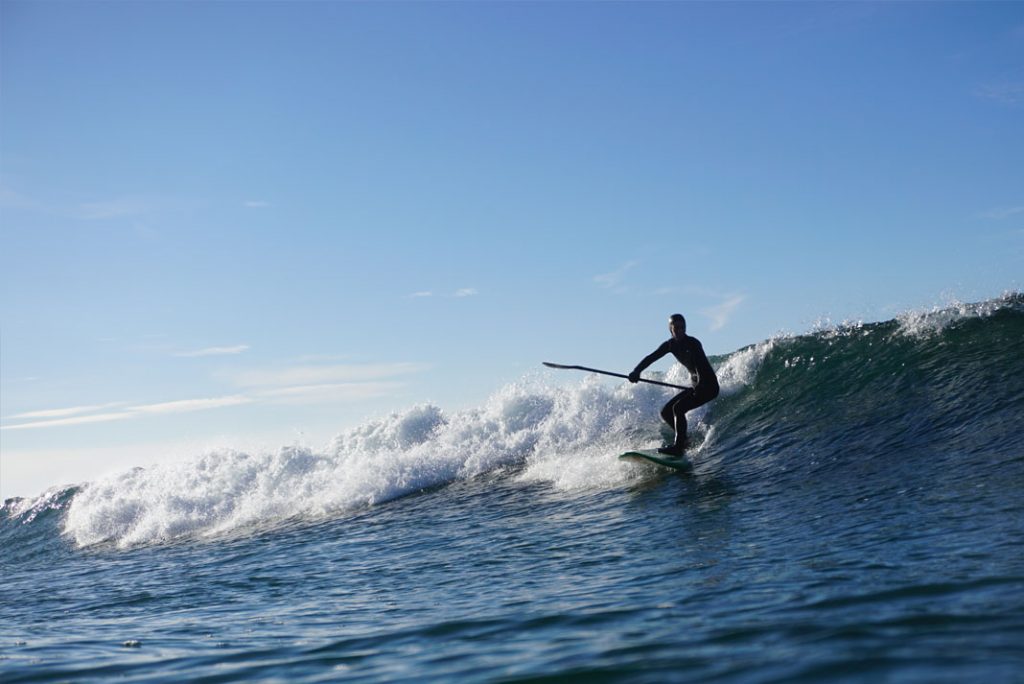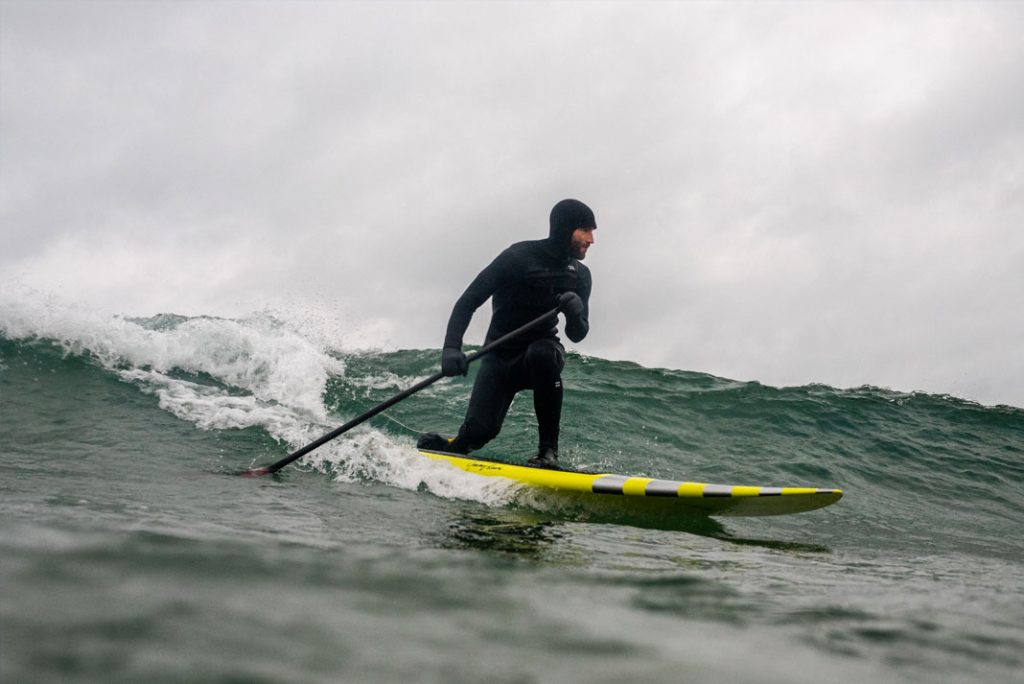Paddle in hand and with a bigger board under your feet, SUP surfing looks a little different than prone surfing. At its core, the wave riding is the same. On your paddleboard, you can still enjoy the feeling of flying effortlessly, riding the energy of the swell as you lean from rail to rail and enjoy the ride. Here’s what you need to know to get started.
Choosing a SUP for surfing
Most SUP surfboards feature a narrow tail and lots of rocker. Beginners should choose a board size at least 10 liters bigger than the board you paddle in flatwater—waves, swell and chop require larger volume for stability. Start with a board in the 9.5- to 11-foot range in length. Boards less than 30 inches wide will feel unstable for beginners.
The bigger the board, the more stable and forgiving it will be. Your positioning on the board and the wave doesn’t need to be as exact, and it’ll allow you to catch waves more easily with less self-generated speed. The trade-off with a bigger board is less maneuverability. With increased skill and wave experience, paddlers can move to smaller boards to ride a wave at its maximum fun capacity.
Renting SUP surfboards from your local shop allows you to experiment with different models, brands, shapes, constructions and sizes to match your current abilities and the daily conditions until you are ready to own a small quiver of boards. There is no one magic board that works for all situations, as changing conditions and skill level dictate different shapes and sizes of appropriate boards.
Surfing with an inflatable
Inflatable SUPs will eventually reach their limit in high-performance surfing, but that’s less of a concern for beginners. When surfing an inflatable, opt for a surf-specific model and pump to maximum PSI. Inflatables tend to be limited to catching waves and surfing a straight line, as such thick rails make it harder to dig into the side of the wave to maneuver the board sharply.
Sizing your paddle
SUP surfers generally use paddles with smaller blades than touring blades for less resistance and higher cadence strokes.
When sizing your paddle for SUP surfing, a rough guide is a paddle approximately matching your height, but ultimately it comes down to personal preference and board size. Your surf paddle will be slightly shorter than your touring paddle to compensate for your body bending and compressing to balance in chop and swell, which brings you closer to the water.
An excellent investment for newbies is buying a high-quality, adjustable or custom-fitted fixed paddle. Having your own paddle allows you to easily travel and be comfortable no matter what board you are riding.
What to wear
Expect to spend a lot of time in the water when you’re learning to SUP surf. To stay nimble, avoid bulky drysuits. Surfing wetsuits are made for maximum mobility and comfort and are the only attire I recommend. For winter surfing in the Great Lakes region and Canadian coasts, wear a hooded wetsuit with a 5/4 or 6/5 thickness rating. For summer surfing, a shortie in a 3/2 or 4/3 is usually sufficient. You can dress down one grade of thickness from what a prone surfer would wear as you won’t spend as much time in the water.
Surf booties and gloves are necessary for the colder months. A winter kayaking glove is better for grasping the paddle shaft, as opposed to bulky surfing gloves.
You’ll also need a leash. Make sure it’s rated for surfing big boards, attached properly to both your board and ankle, and also check for length—the general rule is your leash should be at least the length of your board. Never use coiled leashes, as they’ll cause the board to bounce back at you.
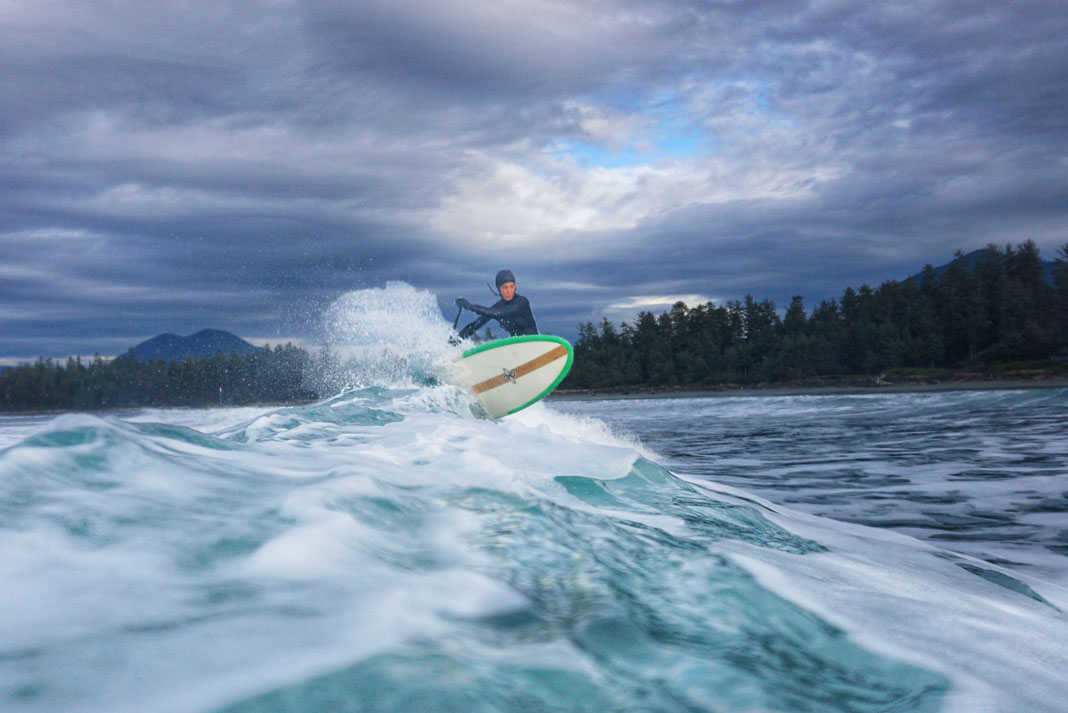
Is SUP surfing easier than prone surfing?
Not exactly. When learning to prone surf, you are laying down and catching whitewash waves. This is easy to learn in an afternoon lesson, and broken waves are easier to spot and catch. Surfers also don’t have to maintain balance as they paddle for waves and they often learn where they can stand in the water and easily position their boards.
When learning to catch waves on a SUP, you’ll stand on a board in deeper water and need to balance, gain speed, turn the board and position yourself in the unbroken swell, which is harder to identify. Your foot position also needs to change from the regular SUP square stance to a surf stance at the right time.
Wannabe SUP surfers will benefit from being able to comfortably perform advanced paddling maneuvers like pivot turns and different foot stances before trying to surf. Fortunately, the skills needed to paddle out and catch waves and the foot positioning for riding waves can all be practiced and honed while paddling flatwater.
Surf safety considerations
Traditional surfers don’t wear PFDs. When leashed to your board, you have a floating device tied to your body and have the ability to hang on if needed. Leashes and boards do break, however. Nothing substitutes strong swimming ability and ocean knowledge.
Because SUPS are larger, less responsive and less maneuverable than prone boards, it’s hazardous to SUP surf in crowds. A 10-foot-long board and 10-foot-long leash create a 20-foot radius that you must keep clear. Your board should never come close to another surfer and you carry the responsibility to keep others safe.
Learning how to navigate the lineup, understanding surf etiquette and wiping out safely are essential skills to master before heading out into waves. Take a lesson or ask an experienced friend before you paddle out. And remember to keep your head up and look both ways to avoid collisions.
Finding the best SUP surfing spots
Finding waves is easier than you think. Coasts and big lakes have waves and—lucky for beginners—you won’t need waves packing much of a punch.
Start in waves just a foot or two tall. Beach breaks with sand bottoms and lots of space, with few crowds, are perfect.
The local SUP or surf shops will be happy to point you in the right direction and warn you of hidden dangers like submerged rocks, shallow breaks or rebar in the water. Online communities spring up around surf hotspots, with paddlers sharing forecasts and meetup plans.
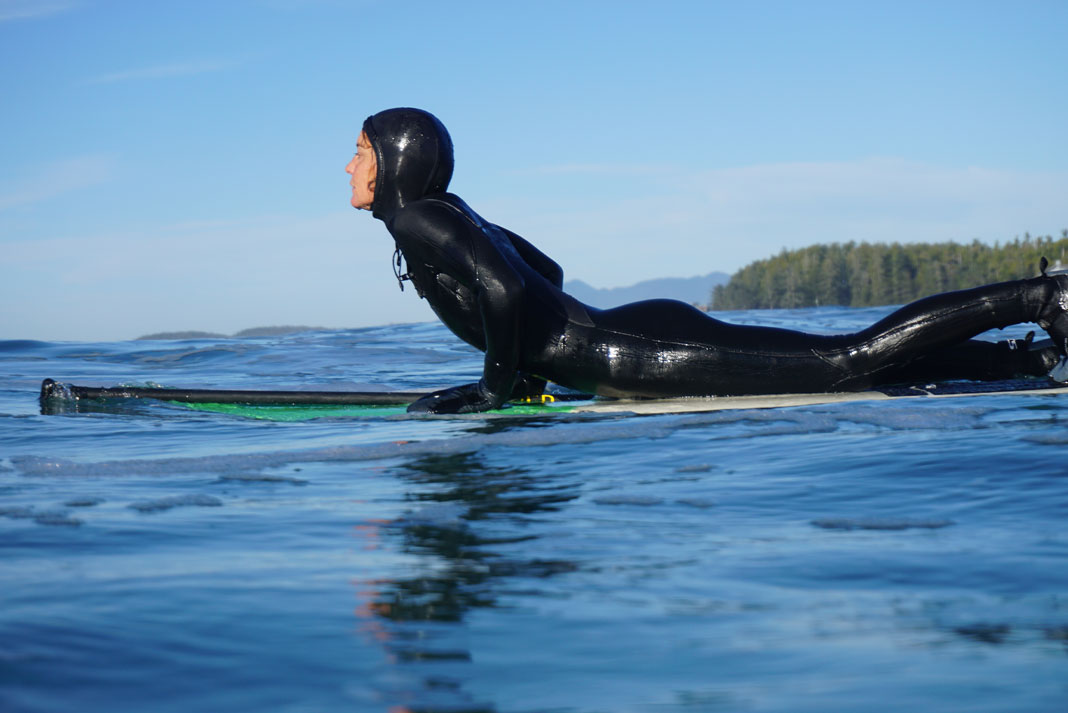
How to SUP surf
Confident technical flatwater paddling ability is the ticket to catching waves on a SUP. If you’ve never tried any kind of surfing, try surfing on a regular board, boogie board or just playing in the waves first. Detailed instruction could fill this entire magazine so here are a couple tips in broad strokes to keep in mind and help you catch your first waves. Above all—taking lessons will speed your progress, refine technique and ensure your safety.
1
To get out past the breaking waves, beginners often find it’s easier to paddle out on their knees or lay prone and hand paddle while the paddle rests under their chest and the handle sticks out over the nose.
2
Once past the breaking waves, standing up on the board in the swell may take patience and perseverance. Remember to bend your knees and keep your feet staggered in a hybrid stance to help stay balanced. Don’t get discouraged if you spend a lot of time in the water.
3
Choose a wave, make sure your path is clear of others, paddle to gain momentum and turn the board towards the beach at the proper place on the wave in your surf stance. Paddle to match the speed of the wave to catch it.
4
Settle into the face of the wave and enjoy the ride—this is the easy part. Use your paddle to amplify your turns by leaning into your paddle when maneuvering, but don’t use it to brace or balance you. When starting out, it helps to have your paddle on the wave side of your body.
5
Enjoy a cold beer on shore and a long nap.
The most common difficulty new-to-surfing paddleboarders run into is not catching the wave. Usually, this is because new surfers are too far back on their boards. Just like paddling in the flatwater, when paddling for a wave, body weight needs to be perfectly distributed so the board is flat in the water. If you are too far back, the board’s nose will come out of the water and its sinking tail will cause you to slow down and not let the board plane. If you are too far forward, you will nosedive. If you are too far out to sea, past the place where the waves are breaking, you will also have trouble catching a wave.
A smaller SUP will be more maneuverable when doing turns, but paddling out and catching waves will be more challenging. Work on your balance and paddling skills, gain experience and practice until wave catching is easy and natural. Then graduate to a smaller board.
Catherine Bruhwiler is a lifelong Tofino, British Columbia local, and one of Canada’s top surfers. She teaches paddleboarding and surfing full time through her beachfront business Tofino Paddle Surf.
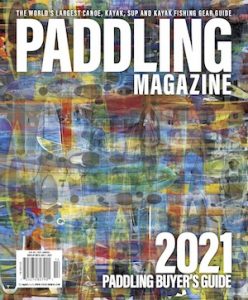
You’ll need a few years of practice—or more like a lifetime—to catch waves like Olympic hopeful Catherine Bruhwiler. | Feature photo: Zak Cross


